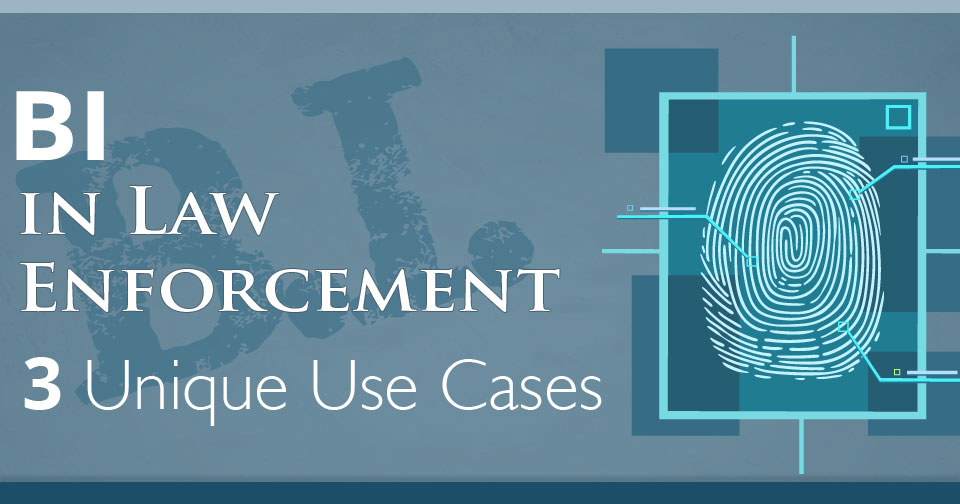Information catches criminals.
That’s always been a fact.
Law enforcement agencies have been taking advantage of data analytics since the mid-1990’s.
But it’s only been within the last few years, however, that a flurry of programs launched across the country have begun to fully realize the potential of data intelligence in preventing crime.

History
The first application of of business intelligence in law enforcement was the CompStat program in 1995. CompStat provided management intelligence to police departments around the country, and included basic forms of the advanced crime maps and predictive models employed across law enforcement organizations today.
CompStat, however, was not updated with real-time information the way modern tools are. And it relied heavily on human interpretation of data. Sweeping improvements in technology have since made data science one of the most important tools for both local and national law enforcement agencies.
In fact, the future portrayed in the 2003 science fiction film Minority Report has already been realized. The film portrayed police using superhuman “precogs” to predict crime, allowing them to arrest the individual before the act could be committed.
Today, business intelligence helps law enforcement prevent crime not only by deterring criminals, but by making the world less crime-friendly, neighborhood by neighborhood.
Real-Time Crime Monitoring with the NYPD’s Domain Awareness System
The New York City Police Department’s initiative to categorize and study movements around the nation’s largest city would seem impossible, even for business intelligence.
But it’s not. A program called the Domain Awareness System (DAS) allows officers to follow traffic patterns through thousands of CCTV cameras, read license plates, integrate data on suspects from multiple databases, and even discover the type of emission a vehicle is letting off.
The cameras help the NYPD scan pedestrian and vehicular traffic for unusual or red-flag trends. They are located throughout the city, but are focused at high risk areas, like tunnels and bridges.
Radiation detectors are also installed, providing data for potential incursions from anything as innocuous as chemotherapy and X-rays, to more pernicious industrial uses or terrorism.
The system updates in real time, and is monitored around the clock from a tracking center in Lower Manhattan.
The NYPD later created an app which could be used to access the DAS on the fly, so that mobile officers on the street have access to the latest intelligence.
Analyzing data has also helped the department maintain its internal integrity. Data gathered from stop-and-frisk arrests helped the department identify and lower racial profiling incidents.
Smart Policing Initiative: Stopping Crime Before it Happens
While it’s commonly known that data can help track criminals, the latest data science is helping to stop crime before it ever starts in cities across the country.
The Smart Policing program, implemented in 38 different American police departments, funds and empowers local, data-focused, crime prevention tactics.
A key feature of the program is “hot spot policing” which analyzes geographic patterns to uncover highly likely crime locales.
Analysis incorporates information from GIS mapping and predictive analytics to search for trends in criminal activity, and to determine its root causes.
For example, from 2012-2013, analytics helped the Philadelphia Police Department identify at-risk areas for crime and sending more regular patrols to those places. The result was a 39% reduction in home burglaries.
The program is part of a partnership between the CNA Corporation, a non-profit, and the Bureau of Justice Assistance.
Improving Efficiency in the Atlanta Police Department
The Atlanta Police Department is benefitting from a unique application of big data in law enforcement.
Oracle and Georgia Tech partnered on the unique Data Science for Social Good Initiative, assigning 10 interns the opportunity apply data science towards social issues.
The program aims to demonstrate to governmental and non-profit organizations how data analytics can be employed for social issues.
One Ph.D student in computer science, Umashanthi Pavalanthan, worked with collected 911 data to study response rates to calls. This helped to optimize dispatcher performance, and even address the placement of patrols throughout Atlanta.
 Choosing a BI vendor is all about finding the right fit. Our exclusive report will walk you through the process and help you select the perfect solution.
Choosing a BI vendor is all about finding the right fit. Our exclusive report will walk you through the process and help you select the perfect solution.